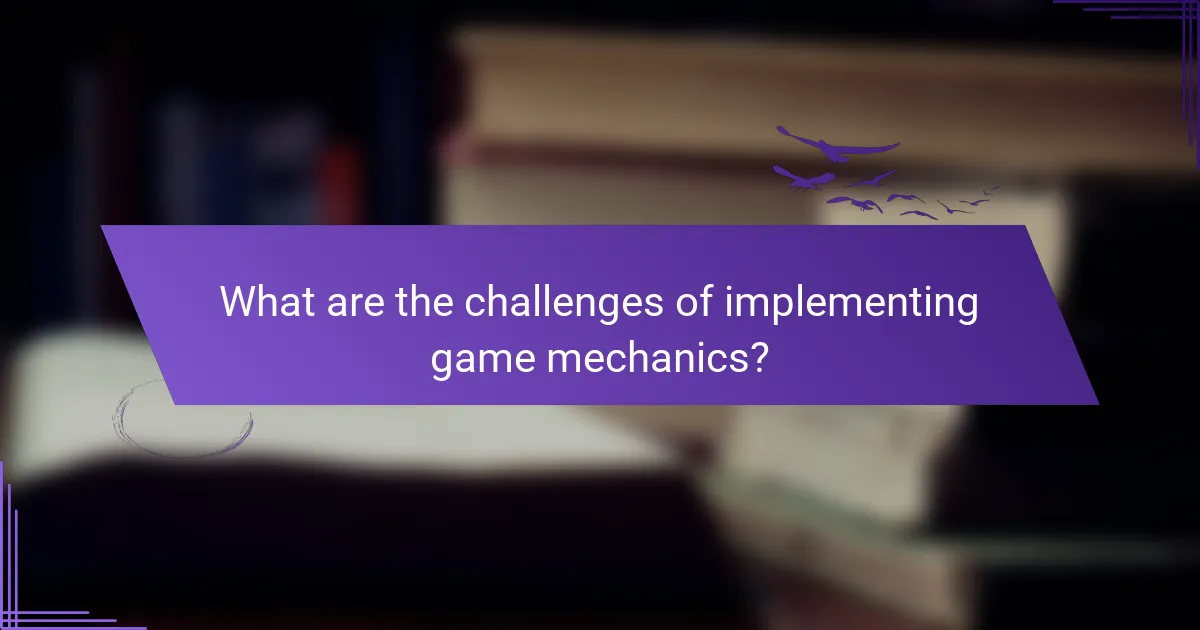Integrating effective game mechanics into Learning Management Systems (LMS) can significantly enhance learner engagement and motivation. By incorporating elements such as rewards, competition, and interactive features, these systems transform traditional educational experiences into dynamic and enjoyable activities. Platforms like Moodle, Canvas, and Blackboard exemplify how game-based learning can lead to improved user engagement and better learning outcomes.

What are effective game mechanics for online courses?
Effective game mechanics for online courses enhance engagement and motivation by incorporating elements that mimic gaming experiences. These mechanics can transform traditional learning into interactive and rewarding activities, making the educational process more enjoyable and effective.
Points and scoring systems
Points and scoring systems provide learners with measurable feedback on their progress. By assigning points for completing tasks, participating in discussions, or achieving specific milestones, students can see their advancement in real-time.
Consider implementing a tiered scoring system where students earn points based on the difficulty of tasks. For example, completing a basic quiz might yield 10 points, while a more complex project could offer 50 points. This encourages learners to tackle more challenging material.
Leaderboards and competition
Leaderboards foster a sense of competition among learners, motivating them to improve their performance. By displaying rankings based on points earned, students can see how they compare to their peers, which can drive engagement.
When using leaderboards, ensure they are updated frequently to maintain interest. However, be mindful of the competitive aspect; some students may feel discouraged if they consistently rank low. Consider offering different categories, such as “Most Improved” or “Best Team Player,” to celebrate various achievements.
Quests and challenges
Quests and challenges turn learning objectives into engaging missions. By framing tasks as quests, students can navigate through a storyline or thematic context, making the learning experience more immersive.
Design challenges that require collaboration or problem-solving, such as group projects or timed assignments. For instance, a quest could involve completing a series of modules to unlock a final project, encouraging continuous participation and teamwork.
Feedback and rewards
Feedback and rewards are crucial for reinforcing positive behaviors and guiding learners. Providing immediate feedback on assignments helps students understand their strengths and areas for improvement.
Incorporate rewards such as badges or certificates for completing courses or achieving specific goals. These tangible acknowledgments can boost motivation and encourage learners to pursue additional challenges. Regularly review the effectiveness of your feedback mechanisms to ensure they meet learners’ needs.

How can game mechanics enhance learner engagement?
Game mechanics can significantly boost learner engagement by incorporating elements that motivate, retain, and connect learners. By leveraging rewards, interactive features, and competition, educational platforms can create a more immersive and enjoyable learning experience.
Increased motivation through rewards
Rewards are a powerful tool in game mechanics that can enhance motivation among learners. By providing points, badges, or certificates for completing tasks, learners feel a sense of achievement that encourages further participation. For instance, a learning management system (LMS) might offer digital badges for completing modules, which can motivate users to progress through the course.
To effectively implement rewards, consider setting clear goals and milestones. This helps learners understand what they need to achieve to earn rewards, fostering a sense of purpose. Avoid overwhelming learners with too many rewards at once; instead, focus on meaningful achievements that align with learning objectives.
Improved retention via interactive elements
Interactive elements, such as quizzes, simulations, and gamified activities, can significantly improve knowledge retention. These features engage learners actively, making it easier for them to remember information compared to passive learning methods. For example, incorporating scenario-based quizzes allows learners to apply concepts in real-world situations, reinforcing their understanding.
When designing interactive content, ensure it is relevant and appropriately challenging. Too easy or too difficult tasks can lead to disengagement. Aim for a balance that keeps learners challenged yet capable, which can enhance their retention rates effectively.
Social interaction through competition
Competition can foster social interaction among learners, making the educational experience more dynamic. By introducing leaderboards or team challenges, learners are encouraged to collaborate and engage with peers, which can enhance their motivation and commitment to learning. For example, a course might feature weekly challenges where learners earn points for teamwork and problem-solving.
To maximize the benefits of competition, create a supportive environment that emphasizes collaboration over cutthroat rivalry. Encourage learners to celebrate each other’s successes and provide constructive feedback. This approach can cultivate a community of learners who are motivated to improve together while enjoying the competitive aspects of the learning process.

Which Learning Management Systems support game mechanics?
Several Learning Management Systems (LMS) effectively integrate game mechanics to enhance user engagement and learning outcomes. Notable platforms include Moodle, Canvas, and Blackboard, each offering unique features that facilitate game-based learning.
Moodle with gamification plugins
Moodle supports gamification through various plugins that allow educators to incorporate game elements into their courses. These plugins can add features like badges, leaderboards, and points systems, which motivate learners by rewarding their achievements.
To implement gamification in Moodle, instructors can explore plugins such as Level Up! and Game, which provide customizable options for tracking progress and enhancing interactivity. This flexibility enables educators to tailor the gaming experience to suit their specific teaching goals.
Canvas LMS with game-based learning features
Canvas LMS offers built-in features that support game-based learning, making it easier for educators to create engaging content. The platform allows for the integration of quizzes and interactive assignments that can simulate game-like scenarios, encouraging active participation.
Instructors can utilize features like mastery paths, which adapt the learning experience based on student performance, and badges to recognize achievements. These elements help maintain student interest and foster a sense of accomplishment throughout the learning process.
Blackboard with integrated game mechanics
Blackboard incorporates integrated game mechanics to enhance the learning experience, focusing on user engagement and motivation. Features such as leaderboards, badges, and interactive assignments are designed to create a competitive yet supportive learning environment.
Educators can leverage Blackboard’s tools to set up challenges and track student progress, allowing for real-time feedback. This integration not only promotes collaboration among students but also encourages them to take ownership of their learning journey.

What are the prerequisites for integrating game mechanics?
Integrating game mechanics into a learning management system (LMS) requires a clear understanding of the target audience and well-defined learning objectives. These prerequisites ensure that the gamification elements align with learners’ needs and enhance the educational experience.
Understanding learner demographics
To effectively integrate game mechanics, it’s essential to analyze the demographics of your learners, including age, background, and learning preferences. For instance, younger learners may respond better to competitive elements, while adult learners might prefer collaborative or achievement-based mechanics.
Gathering data through surveys or analytics can help identify key characteristics of your audience. This information allows you to tailor game mechanics that resonate with your learners, enhancing engagement and motivation.
Defining learning objectives
Clearly defined learning objectives are crucial for successful integration of game mechanics. These objectives should outline what learners are expected to achieve and how gamification can support these goals. For example, if the objective is to improve problem-solving skills, incorporating challenges or puzzles can be effective.
Ensure that the game mechanics directly align with the learning outcomes. Using a framework like SMART (Specific, Measurable, Achievable, Relevant, Time-bound) can help in formulating these objectives, making it easier to evaluate the effectiveness of the gamification strategy.

How to choose the right game mechanics for your course?
Selecting the appropriate game mechanics for your course involves understanding your educational objectives and the preferences of your learners. Effective game mechanics can enhance engagement and facilitate deeper learning, making it crucial to align them with your course goals and the needs of your audience.
Aligning mechanics with course goals
To align game mechanics with your course goals, start by clearly defining your educational objectives. Consider what skills or knowledge you want learners to acquire and choose mechanics that support these aims. For instance, if collaboration is a goal, mechanics like team challenges or cooperative quests may be effective.
Additionally, think about the desired outcomes. If you aim to improve retention, consider using mechanics that encourage repetition and practice, such as leveling up or earning rewards for completing tasks. Always ensure that the chosen mechanics reinforce rather than distract from the learning objectives.
Assessing learner preferences
Understanding learner preferences is essential for selecting game mechanics that resonate with your audience. Conduct surveys or informal discussions to gauge what types of games or activities your learners enjoy. This insight can guide you in choosing mechanics that will engage them effectively.
Consider demographic factors, such as age and cultural background, as these can influence preferences. For example, younger learners may prefer fast-paced, competitive mechanics, while adult learners might appreciate more strategic or narrative-driven approaches. Tailoring your mechanics to these preferences can significantly enhance motivation and participation.

What are the challenges of implementing game mechanics?
Implementing game mechanics in Learning Management Systems (LMS) presents several challenges, including technical limitations and the need to balance entertainment with educational outcomes. These obstacles can hinder effective integration and diminish the overall learning experience.
Technical limitations of LMS platforms
LMS platforms often have constraints that can complicate the integration of game mechanics. Many systems may lack the necessary flexibility to support interactive elements, such as real-time feedback or dynamic content updates. This can lead to a subpar user experience if the game mechanics do not function seamlessly within the existing framework.
Additionally, compatibility issues with various devices and browsers can further restrict the implementation of game features. It’s crucial to evaluate the technical capabilities of the LMS and consider potential upgrades or alternative platforms that better support gamification.
Balancing fun and educational value
Finding the right balance between fun and educational value is essential when implementing game mechanics. While engaging elements can motivate learners, they must also align with learning objectives to ensure that educational outcomes are met. Overemphasis on entertainment can detract from the core learning experience.
To achieve this balance, consider incorporating game mechanics that reinforce key concepts, such as quizzes with rewards or progress tracking. Regular feedback and clear connections between game activities and learning goals can help maintain this equilibrium, ensuring that learners remain both engaged and informed.

What are best practices for integrating game mechanics?
Best practices for integrating game mechanics into learning management systems (LMS) involve aligning game elements with educational goals, ensuring user engagement, and providing meaningful feedback. Effective integration enhances motivation and learning outcomes by creating an interactive and rewarding experience for users.
Define clear objectives
Establishing clear objectives is crucial when integrating game mechanics. These objectives should align with the learning outcomes you aim to achieve, such as improving knowledge retention or enhancing collaboration. For example, if the goal is to boost participation, consider implementing point systems or leaderboards to encourage interaction.
Incorporate feedback mechanisms
Feedback mechanisms are essential in game mechanics as they inform users of their progress and areas for improvement. Consider using instant feedback through quizzes or challenges that provide immediate results. This approach helps learners understand their performance and motivates them to improve continuously.
Utilize rewards and incentives
Rewards and incentives can significantly enhance user engagement in an LMS. Implement a system of badges, points, or unlockable content to recognize achievements. For instance, awarding badges for completing modules can encourage learners to progress through the course material.
Ensure accessibility and inclusivity
When integrating game mechanics, it is vital to ensure that all users can access and benefit from these features. Design your game elements to accommodate diverse learning styles and abilities. For example, provide alternative ways to earn rewards, such as completing collaborative tasks for those who may struggle with traditional assessments.
Monitor and evaluate effectiveness
Regularly monitoring and evaluating the effectiveness of game mechanics is essential for continuous improvement. Collect data on user engagement and learning outcomes to assess what works and what doesn’t. Use this information to refine your approach, ensuring that the game mechanics remain relevant and effective in achieving educational goals.


